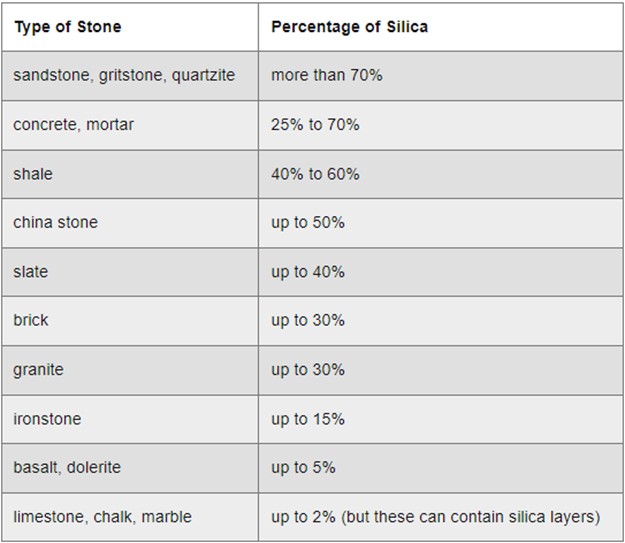November is Lung Cancer Awareness Month, a campaign to raise awareness of common lung cancer symptoms which are often ignored, for example, persistent cough and breathlessness. The majority of lung cancer cases go undetected until the cancer has spread, and symptoms worsen, so it’s vital that the symptoms are recognised and investigated as early as possible.
COPD and respiratory diseases are common problems amongst workers in the construction industry, due to exposure to harmful substances such as asbestos and silica dust. Those with COPD have an increased risk of developing lung cancer, so it’s vital to understand how to minimise the risk of exposure to these harmful substances.
Continue reading to learn more about the risks of exposure to respirable crystalline silica (RCS) and what can be done to prevent negative health implications for staff.
What is Silica Dust?
Silica is a natural substance commonly found in rocks, sand and clay. The amount of silica found is dependent on the material, for example, granite may contain 15-30% silica, whereas sandstone contains more than 70%. Due to this, silica is a major component of construction materials (e.g. tiles, concrete, brick and mortar).
When these construction materials are used on site, dust is produced through drilling, cutting, grinding and polishing. Some of this dust will be fine enough to be inhaled into your lungs – this is known as respirable crystalline silica (RCS) or silica dust.
What Are the Risks?
Prolonged or heavy exposure to silica dust can lead to several serious respiratory diseases, including lung cancer, silicosis, and chronic obstructive pulmonary disease (COPD). This is due to fibrosis (hardening or scarring) of the lung tissue, resulting in a loss of function. The symptoms of these conditions are irreversible, and include:
- Severe breathing problems
- Increased risk of lung infections
- Prolonged coughing
- Chronic disability
HSE commissioned estimates that exposure to RCS was responsible for the death of over 500 construction workers in 2005, plus around 4000 deaths each year due to COPD from past workplace exposures.
Who is Most at Risk?
As previously mentioned, construction workers are most at risk of exposure to RCS, alongside those working in quarrying, slate works, foundries, potteries, and stonemasonry. This will depend on the materials being used – please see the table below for levels of silica in various materials.

How to Control Exposure to RCS
It’s vital that employers and their workers are aware of the risks of silica dust and have the correct control measures in place to prevent exposure. It is a legal requirement (under The Control of Substances Hazardous to Health Regulations 2002) to assess the risks, control the risks, and review these control measures. Control measures could include:
- Stopping or reducing the dust. This could be done by using different materials or less powerful tools. Silica-free abrasives can be used to reduce risks when blasting.
- Controlling the dust. To stop dust getting into the air, water can be used – it must be supplied at the correct levels to be effective. On-tool extraction technology can also be used to remove dust as it is being produced (i.e., an exhaust ventilation tube).
- Respiratory protective equipment (RPE). This is the last line of protection and should be suitable for providing adequate protection for the wearer (at least 20 APF).
- Limiting the number of people near the work – this could also be an enclosed area.
- Rotating staff who are completing the work.
- Selecting appropriate workwear that does not hold onto dust.
- Train workers on the risk of dust inhalation and how this can impact their health.
Choosing Suitable Respiratory Protective Equipment (RPE)
As previously mentioned, RPE is a control method that can be used to help reduce exposure to RCS and other harmful dust particles. RPE should be carefully selected to ensure it is:
- Adequate for the levels and type of dust. You should consider the assigned protection factor (APF) to understand how much protection will be provided.
- Suitable for the job. If the work is being completed over a long period of time (1 hour+), disposables and half masks may be uncomfortable. You may want to consider powered RPE.
- Compatible with any other protective workwear worn.
- Fits the wearer comfortably – face fit testing may be required.
- Worn correctly. Training should be provided where necessary, tight-fitting masks also require the user to be clean-shaven.
It is important not to solely rely on RPE to prevent exposure to silica dust, but it can be a useful measure in reducing direct exposure to harmful dust particles.
If you require more information on choosing the correct respiratory protective equipment (RPE) for your employees, please get in touch with our sales team.
For more information on lung cancer symptoms, diagnosis, and treatment, please visit the Cancer Research website.
For more in-depth information on the risks and regulations regarding silica dust, please visit the HSE website.




